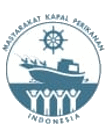POTENSI MAKROALGA PADINA AUSTRALIS (HAUCK 1887) DI BARAT SELATAN ACEH SEBAGAI AGEN INHIBITOR TIROSINASE
Abstract
Full Text:
PDFReferences
Andarwulan S, Fardiaz, Apriyanto P, Haryadi, Shetty NK. 1999. Mobilization of primary metabolites and phenolics during natural fermentation in seeds of Pangiumedule Reinw. Process Biochem. 35: 197-204.
AOAC. 1995. Official methods of analysis of the association of official’s analitical chemist . Washington DC: Agricultural Chemists.
Aleem, A.A. 1993. The marine Algae of Alexandria. Egytian Books House, Egypt.
Aiyegoro OA, Okoh AI. 2010. Preliminary phytochemical screening and in vitro antioxidant activities o the aqueous extract of Helichrysum longifolium DC. BMC Complement Altern Med 10: 21.
Batubara I, Darusman LK, Mitsunaga T, Rahmiwati M, Djauhari E. 2010. Potency of Indonesian Medicinal Plants a Tyrosinase Inhibitor and Antioxidant Agent. J Biol Scie 10: 138-144.
Bengen DG. 2002. Sinopsis Ekosistem dan Sumberdaya Alam Pesisir dan Laut. Pusat Kajian Sumberdaya Pesisir dan Lautan IPB. Bogor.
Bold, H.C. 1978. “Introduction to the algae” Structure and Reproduction. Prentice Hall, Inc., New-Jersey 07632.
Bouck, G.B. 1965. Fine structure and organelle association in brown algae. J. Cell. Biol. 26, 513 – 537.
Coppejans E., Leilaert F., Dargents O, Gunasekara R, Clerck O. 2009. Srilanka Seaweeds Methodologies and Field Guide to the dominant species. University of Ruhuna, Dept. Botany, Matora, Srilanka, pp. 1-265.
Curto EV, Kwong C, Hermersdosfer H, Glatt H, Santis C. 1999. Inhibitor of mammalian melanocyte tyrosinase: in vitro comparisons of alkyl esters of gentisic acid with other putative inhibitor. Biochem Pharm 57: 663-672.
Harborne JB. 1984. Phytochemical Method: A guide to modern techhniques of plant analysis. Second edition. Chapman and Hall. New York.
Kim, Y.-J.; Uyama, H. 2005. Tyrosinase inhibitors from natural and synthetic sources: Structure, inhibition mechanism and perspective for the future. Cell. Mol. Life Sci., 62, 1707–1723.
Nasr A.H. Aleem A.A. 1949. Ecological studies of some marine algae from Alexandria. Hydrobiologia 1, 251 – 281.
Ma W, Wlaschek M, Tantcheva-Poor I, Schneider LA, Naderi L. 2001. Chronological ageing and photoageing of the fibroblasts and the dermal connective tissue. Clin Exp Dermatol 26: 592-599.
Nerya O, Vaya J, Musa R, Izrael S, Ben-Arie R. 2003. Glabrene and isoquiritigenin as tyrosinase inhibitor from liquorice roots. J Agr Food Chem 15: 1201-1207.
Nerya O, Musa R, Khatib S, Tamir S, Vaya J. 2004. Chalcones as potent tyrosinase inhibitors: the effect of hydroxyl position sand numbers. Phytochemistry 65: 1389-1395.
Perluigi M, De Marco F, Foppoli C, Coccia R, Blarzino C. 2003. Tyrosinase protects human melanocytes from ROS-generating compounds. Biochem Biophys Res Comm 305: 250-256.
Prota G, Thomson RH. 1976. Melanin pigmentation in mammals. Endeavor: 35: 32-38.
Shen LR, Guo D, Yu YM, Yin BW, Zhao L, et al. 2009. Chemical constituents of plants from the genus Xylocarpus. Chem Biodivers 6: 1293-1308.
Smith, G. 1944. Marine Algae of Monterey Peninsula. Reprinted from Madrono VII (7), pp. 226 – 231.
Sturm RA, Teasdale RD, Box NF. 2001. Human Pigmentation genes: identification, structure and consequences of polymorphic variation. Gene. 227: 49-62.
Vamos-Vigyazo, L. 1981. Polyphenol oxidase and peroxidase in fruits and vegetables. Crit. Rev. Food Sci. Nutr., 15, 49–127.
Yamakoshi J, Otsuka F, Sano A, Tokutake S, Saito M, et al. 2003. Lightening effect on ultraviolet-induced pigmentation of guinea pig skin by oral administration of a proanthocyanidin-rich extract from grape seeds. Pigment Cell Res 16: 629-638.
Wu, B.; Zhang, X.; Wu, X. 2012. New lignan glucosides with tyrosinase inhibitory activity from exocarp of Castanea henryi. Carbohydr. Res., 355, 45–49.
DOI: https://doi.org/10.35308/jpt.v5i1.1027
Refbacks
- There are currently no refbacks.
Copyright (c) 2019 JURNAL PERIKANAN TROPIS
Jurnal Perikanan Tropis (print ISSN 2355-5564 ;online ISSN 2355-5572), is published by the Faculty of Fisheries and Marine Science Universitas Teuku Umar, Indonesia .

This work is licensed under a Creative Commons Attribution-NonCommercial-ShareAlike 4.0 International License










